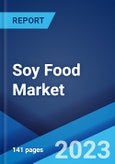Soybean is a type of legume, native to East Asia, which is low in saturated fats but high in protein, vitamin C and folate. It is a good source of iron, fiber, calcium, magnesium, potassium, phosphorus and omega-3 fatty acids. As a result of its nutrient content, it offers various health benefits such as lowering the blood cholesterol level, increasing bone density and minimizing the risk of developing cancer. It is widely used as an alternative of meat in several dishes and is added in various vegan-friendly food products. The rising demand for plant-based foods is strengthening the growth of the soy food market across the globe.
Soybean is used for preparing numerous products including soymilk, soy flour, tofu, tamari, tempeh, edamame, miso, natto and teriyaki. Currently, the demand for tofu is rising around the world, especially among the vegan and vegetarian population. It is an excellent substitute for cheese, which can be consumed by lactose intolerant consumers. The growing sales of tofu can also be accredited to its resemblance to meat in its form, color, taste and texture. Apart from this, other soy food products such as snacks and beverages are also experiencing steady growth in their demand worldwide on account of the growing health awareness among consumers. Further, manufacturers are investing in research and development activities to introduce new variants of soy food products to expand their product portfolio and attract new consumers.
Key Market Segmentation:
The publisher provides an analysis of the key trends in each sub-segment of the global soy food market report, along with forecasts at the global and regional level from 2023-2028. The report has categorized the market based on product type, category, distribution channel and end-use.Breakup by Product Type:
- Textured Vegetable Protein (TVP)
- Soy Milk
- Soy Oil
- Tofu
- Others
Breakup by Category:
- Organic
- Conventional
Breakup by Distribution Channel:
- Supermarkets and Hypermarkets
- Departmental Stores
- Convenience Stores
- Online
- Others
Breakup by End-Use:
- Dairy Alternatives
- Meat Alternatives
- Bakery and Confectionary
- Functional Foods
- Infant Nutrition
- Others
Breakup by Region:
- Asia Pacific
- North America
- Europe
- Middle East and Africa
- Latin America
Competitive Landscape:
The report has also analysed the competitive landscape of the market with some of the key players Blue Diamond Growers, Dean Foods, Earth's Own Food Company, Eden Foods, Freedom Foods Group, Harvest Innovations, House Foods America Holding, Archer Daniels Midland, Miracle Soybean Food International Corp, Cargill, Nordic Soya Oy, Victoria Group, Hain Celestial, Adisoy Foods & Beverages Pvt. Ltd., etc.Key Questions Answered in This Report
1. What was the size of the global soy food market in 2022?2. What is the expected growth rate of the global soy food market during 2023-2028?
3. What are the key factors driving the global soy food market?
4. What has been the impact of COVID-19 on the global soy food market?
5. What is the breakup of the global soy food market based on the product type?
6. What is the breakup of the global soy food market based on the category?
7. What is the breakup of the global soy food market based on the distribution channel?
8. What is the breakup of the global soy food market based on the end-use?
9. What are the key regions in the global soy food market?
10. Who are the key players/companies in the global soy food market?
Table of Contents
Companies Mentioned
- Blue Diamond Growers
- Dean Foods
- Earth's Own Food Company
- Eden Foods
- Freedom Foods Group
- Harvest Innovations
- House Foods America Holding
- Archer Daniels Midland
- Miracle Soybean Food International Corp
- Cargill
- Nordic Soya Oy
- Victoria Group
- Hain Celestial
- Adisoy Foods & Beverages Pvt. Ltd.
Methodology

LOADING...
Table Information
| Report Attribute | Details |
|---|---|
| No. of Pages | 141 |
| Published | September 2023 |
| Forecast Period | 2022 - 2028 |
| Estimated Market Value ( USD | $ 47.1 Billion |
| Forecasted Market Value ( USD | $ 62.4 Billion |
| Compound Annual Growth Rate | 4.8% |
| Regions Covered | Global |
| No. of Companies Mentioned | 14 |









